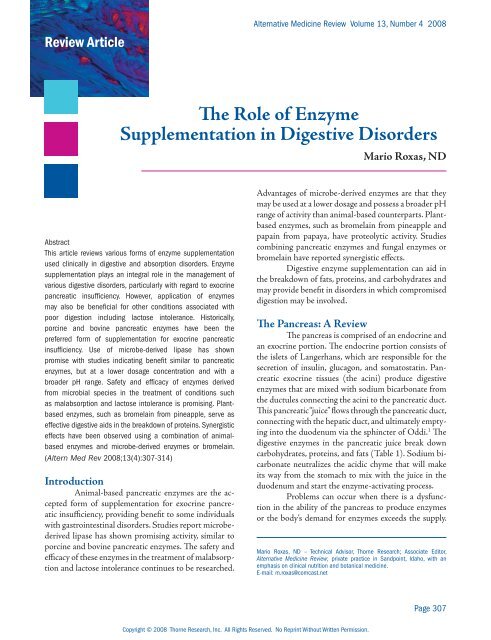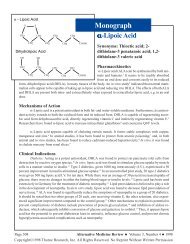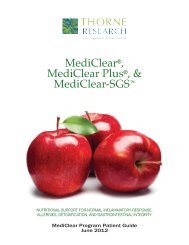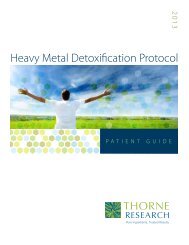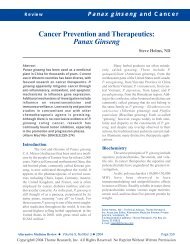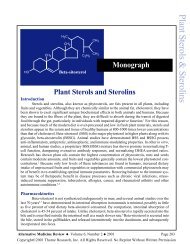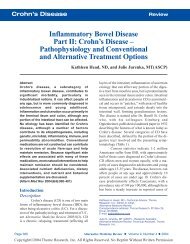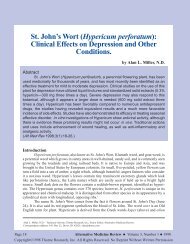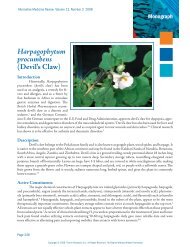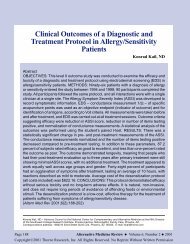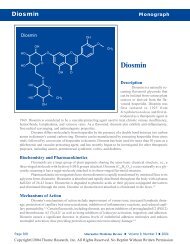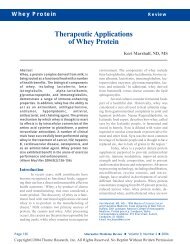The Role of Enzyme Supplementation in Digestive Disorders
The Role of Enzyme Supplementation in Digestive Disorders
The Role of Enzyme Supplementation in Digestive Disorders
Create successful ePaper yourself
Turn your PDF publications into a flip-book with our unique Google optimized e-Paper software.
Review ArticleAlternative Medic<strong>in</strong>e Review Volume 13, Number 4 2008Table 1. Pancreatic <strong>Enzyme</strong>s <strong>in</strong> Digestion<strong>Enzyme</strong>Enterok<strong>in</strong>ase (actually secreted<strong>in</strong> the small <strong>in</strong>test<strong>in</strong>e)Proteolytic <strong>Enzyme</strong>s:Tryps<strong>in</strong>ogen (tryps<strong>in</strong>)Chymotryps<strong>in</strong>ogen (chymotryps<strong>in</strong>)CarboxypolypeptidaseAlso various elastases andnucleasesAmylolytic <strong>Enzyme</strong>s:Pancreatic amylaseLipolytic <strong>Enzyme</strong>s:LipasePhosphalipase A1, A2EsteraseOptimal pH Range5.2-6.07.9-9.76.7-7.28.0ActionTransforms tryps<strong>in</strong>ogen <strong>in</strong>to tryps<strong>in</strong><strong>in</strong> duodenumTryps<strong>in</strong> and chymotryps<strong>in</strong> break downprote<strong>in</strong>s <strong>in</strong>to polypeptides anddipeptides; carboxypolypeptidasesplits peptides <strong>in</strong>to <strong>in</strong>dividual am<strong>in</strong>oacidsHydrolyzes starches, glycogen, andother carbohydrates (other thancellulose) <strong>in</strong>to disaccharides andsome trisaccharidesLipase hydrolyzes fats <strong>in</strong>to fattyacids and monoglycerides; phospholipasessplit fatty acids from phospholipids;esterase hydrolyzescholesterol estersThis dysfunction can occur for a variety <strong>of</strong> reasons, <strong>in</strong>clud<strong>in</strong>ggenetic predisposition, illness, <strong>in</strong>jury/trauma,excessive exercise, ag<strong>in</strong>g, toxic exposure, or a comb<strong>in</strong>ationthere<strong>of</strong>. A deficiency <strong>of</strong> pancreatic enzymes couldpotentially contribute to the development <strong>of</strong> numerousillnesses and degenerative conditions.Pancreatic <strong>Enzyme</strong> <strong>Supplementation</strong>Chymotryps<strong>in</strong>, tryps<strong>in</strong>, pancreat<strong>in</strong>, and pancrelipase,either <strong>in</strong>dividually or <strong>in</strong> comb<strong>in</strong>ation, are thekey components <strong>of</strong> most common pancreatic supplementsused <strong>in</strong> health care and are primarily extractedfrom porc<strong>in</strong>e or bov<strong>in</strong>e sources. 2 Lipase may also besynthesized from microbial sources, such as Aspergillusoryzae and Rhizopus arrhizus. 3-5U.S. Pharmacopoeia (U.S.P.) grade chymotryps<strong>in</strong>and tryps<strong>in</strong> are crystallized from ox pancreas gland extract,pancrelipase is derived from hog pancreas, and pancreat<strong>in</strong>is extracted from both hog and ox sources. 2<strong>The</strong> activity and concentration <strong>of</strong> these enzymesare determ<strong>in</strong>ed by multiple factors, <strong>in</strong>clud<strong>in</strong>g theanimal’s species, age and sex, as well as husbandry practices.<strong>The</strong> physiology <strong>of</strong> hogs, especially the pancreas,is more similar to humans than any other animal species.6 Enzymatic activity levels from pork sources areapproximately 30- to 50-percent higher than beefsources. While porc<strong>in</strong>e pancreas is particularly rich <strong>in</strong>amylase and lipase, bov<strong>in</strong>e pancreas is rich <strong>in</strong> proteolyticenzymes but substantially lower <strong>in</strong> amylase and lipase.Sow glands are high <strong>in</strong> lipase, whereas butcher hogs(young male hogs up to 90 kg <strong>in</strong> weight and six months<strong>of</strong> age) are high <strong>in</strong> protease. <strong>Enzyme</strong> levels <strong>in</strong> beef cowsand bulls differ significantly from those found <strong>in</strong> steersor heifers.Plant-Based <strong>Enzyme</strong> PreparationsAs the name implies, plant-based enzymepreparations are derived from plant sources, such asp<strong>in</strong>eapple and papaya. Bromela<strong>in</strong> is a general name forthe family <strong>of</strong> sulfhydryl-conta<strong>in</strong><strong>in</strong>g, proteolytic enzymesfrom the p<strong>in</strong>eapple fruit and stem. Bromela<strong>in</strong> also conta<strong>in</strong>sa peroxidase, acid phosphatase, several proteasePage 308Copyright © 2008 Thorne Research, Inc. All Rights Reserved. No Repr<strong>in</strong>t Without Written Permission.
Review ArticleAlternative Medic<strong>in</strong>e Review Volume 13, Number 4 2008or pH-protected to ensure activity <strong>in</strong> the small <strong>in</strong>test<strong>in</strong>e.Pancreatic lipase is a relatively fragile enzyme and becomesirreversibly <strong>in</strong>activated at a lumen pH
Review ArticleAlternative Medic<strong>in</strong>e Review Volume 13, Number 4 2008Lactose as a Supplement DiluentLactose is used as a diluent <strong>in</strong> numerouspharmaceutical and nutritional preparations, <strong>in</strong>clud<strong>in</strong>g<strong>in</strong> bromela<strong>in</strong>, papa<strong>in</strong>, peps<strong>in</strong>, and pancreat<strong>in</strong>. <strong>The</strong> U.S.Pharmacopoeia states that each milligram <strong>of</strong> NationalFormulary (N.F.) or U.S.P. peps<strong>in</strong> should digest between3,000 and 3,500 times its weight <strong>of</strong> coagulated eggalbum<strong>in</strong>. When a peps<strong>in</strong> with higher digestive activityis used it is mixed with lactose to reduce its digestivepotency to the <strong>of</strong>ficial standard.* Lactose is also theprimary substance used to dilute U.S.P. pancreat<strong>in</strong>.Each milligram <strong>of</strong> U.S.P. pancreat<strong>in</strong> is standardized toconta<strong>in</strong> no less than 25 U.S.P. units <strong>of</strong> amylase activity,2.0 U.S.P. units <strong>of</strong> lipase activity, and 25 U.S.P. units <strong>of</strong>protease. Both peps<strong>in</strong> and pancreat<strong>in</strong> preparations <strong>of</strong>higher digestive power are labeled as a whole numbermultiple (e.g., 2X, 3X).* Manufacturer analysis <strong>of</strong> rawpancreat<strong>in</strong> <strong>in</strong>dicates the pure product displays notless than 9X <strong>of</strong> the U.S.P. value. Thus, one gram <strong>of</strong> purepancreat<strong>in</strong> conta<strong>in</strong>s approximately 235,000-275,000units <strong>of</strong> amylase activity, 220,000-270,000 units <strong>of</strong>protease activity, and 18,000-40,000 units <strong>of</strong> lipaseactivity.*<strong>The</strong> United States Pharmacopeia (22nd revision),<strong>The</strong> National Formulary (17th ed), United StatesPharmacopeial Convention, Inc.: Rockville, MD;1990.<strong>The</strong> 27 lactose-<strong>in</strong>tolerant children were then given the enzymepreparations with whole milk. Both K. lactis- andA. oryzae-derived enzymes significantly reduced hydrogenbreath excretion (p
Review ArticleAlternative Medic<strong>in</strong>e Review Volume 13, Number 4 200814. Billigmann P. <strong>Enzyme</strong> therapy – an alternative <strong>in</strong>treatment <strong>of</strong> herpes zoster. A controlled study <strong>of</strong> 192patients. Fortschr Med 1995;113:43-48. [Article <strong>in</strong>German]15. Bergkvist R, Svaerd PO. Studies on the thrombolyticactivity <strong>of</strong> a protease from Aspergillus oryzae. Acta PhysiolScand 1964;60:363-371.16. Verhaeghe R, Verstraete M, Schetz J, et al. Cl<strong>in</strong>ical trial<strong>of</strong> br<strong>in</strong>ase and anticoagulants as a method <strong>of</strong> treatmentfor advanced limb ischemia. Eur J Cl<strong>in</strong> Pharmacol1979;16:165-170.17. Kiessl<strong>in</strong>g H, Svensson R. Influence <strong>of</strong> an enzyme fromAspergillus oryzae, protease I, on some components <strong>of</strong> thefibr<strong>in</strong>olytic system. Acta Chem Scand 1970;24:569-579.18. Larsson LJ, Frisch EP, Torneke K, et al. Properties <strong>of</strong> thecomplex between alpha 2-macroglobul<strong>in</strong> and br<strong>in</strong>ase,a prote<strong>in</strong>ase from Aspergillus oryzae with thrombolyticeffect. Thromb Res 1988;49:55-68.19. Vanhove P, Donati MB, Claeys H, et al. Action <strong>of</strong>br<strong>in</strong>ase on human fibr<strong>in</strong>ogen and plasm<strong>in</strong>ogen. ThrombHaemost 1979;42:571-581.20. Nair RJ, Lawler L, Miller MR. Chronic pancreatitis. AmFam Physician 2007;76:1679-1688.21. Cystic Fibrosis Foundation. www.cff.org:80/aboutcf/[Accessed October 1, 2008]22. American Diabetes Association. www.diabetes.org/about-diabetes.jsp [Accessed October 1, 2008]23. Hardt PD. Prevalence and Cl<strong>in</strong>ical Relevance <strong>of</strong> Exocr<strong>in</strong>ePancreatic Insufficiency <strong>in</strong> Diabetes Mellitus. First WorldCongress on Controversies <strong>in</strong> Obesity, Diabetes andHypertension. Berl<strong>in</strong>, Germany. October 26-29, 2006.24. Layer P, Keller J. Lipase supplementation therapy:standards, alternatives, and perspectives. Pancreas2003;26:1-7.25. Keller J, Layer P. Pancreatic enzyme supplementationtherapy. Curr Treat Options Gastroenterol2003;6:369-374.26. Dodge JA, Turck D. Cystic fibrosis: nutritionalconsequences and management. Best Pract Res Cl<strong>in</strong>Gastroenterol 2006;20:531-546.27. Graham DY. <strong>Enzyme</strong> replacement therapy <strong>of</strong> exocr<strong>in</strong>epancreatic <strong>in</strong>sufficiency <strong>in</strong> man. Relations between <strong>in</strong>vitro enzyme activities and <strong>in</strong> vivo potency <strong>in</strong> commercialpancreatic extracts. N Engl J Med 1977;296:1314-1317.28. DiMagno EP, Malagelada JR, Go VL, Moertel CG. Fate<strong>of</strong> orally <strong>in</strong>gested enzymes <strong>in</strong> pancreatic <strong>in</strong>sufficiency.Comparison <strong>of</strong> two dosage schedules. N Engl J Med1977;296:1318-1322.29. Heizer WD, Cleaveland CR, Iber FL. Gastric<strong>in</strong>activation <strong>of</strong> pancreatic supplements. Bull JohnsHopk<strong>in</strong>s Hosp 1965;116:261-270.30. Go VL, Poley JR, H<strong>of</strong>mann AF, Summerskill WH.Disturbances <strong>in</strong> fat digestion <strong>in</strong>duced by acidicjejunal pH due to gastric hypersecretion <strong>in</strong> man.Gastroenterology 1970;58:638-646.31. DiMagno EP. Controversies <strong>in</strong> the treatment <strong>of</strong> exocr<strong>in</strong>epancreatic <strong>in</strong>sufficiency. Dig Dis Sci 1982;27:481-484.32. Regan PT, Malagelada JR, DiMagno EP, et al.Comparative effects <strong>of</strong> antacids, cimetid<strong>in</strong>e and entericcoat<strong>in</strong>g on the therapeutic response to oral enzymes<strong>in</strong> severe pancreatic <strong>in</strong>sufficiency. N Engl J Med1977;297:854-858.33. Leung AY. Encyclopedeia <strong>of</strong> Common Natural IngredientsUsed <strong>in</strong> Foods, Drugs, and Cosmetics. New York, NY:John Wiley & Sons; 1980:74-76.34. Knill-Jones RP, Pearce H, Batten J, Williams R.Comparative trial <strong>of</strong> Nutrizym <strong>in</strong> chronic pancreatic<strong>in</strong>sufficiency. Br Med J 1970;4:21-24.35. Balakrishnan V, Hareendran A, Nair CS. Double-bl<strong>in</strong>dcross-over trial <strong>of</strong> an enzyme preparation <strong>in</strong> pancreaticsteatorrhea. J Assoc Physicians India 1981;29:207-209.36. Nakamura T, Takeuchi T, Tando Y. Pancreaticdysfunction and treatment options. Pancreas1998;16:329-336.37. Schneider MU, Knoll-Ruzicka ML, DomschkeS, et al. Pancreatic enzyme replacement therapy:comparative effects <strong>of</strong> conventional and enteric-coatedmicrospheric pancreat<strong>in</strong> and acid-stable fungal enzymepreparations on steatorrhoea <strong>in</strong> chronic pancreatitis.Hepatogastroenterology 1985;32:97-102.38. Sahi T. Hypolactasia and lactase persistence. Historicalreview and the term<strong>in</strong>ology. Scand J Gastroenterol Suppl1994; 202:1-6.39. Cichoke AJ. <strong>Enzyme</strong>s and <strong>Enzyme</strong> <strong>The</strong>rapy: How toJump-Start Your Way to Life-Long Good Health. LosAngeles, CA: Keats Publish<strong>in</strong>g; 2000:40.40. Lomer MC, Parkes GC, Sanderson JD. Review article:lactose <strong>in</strong>tolerance <strong>in</strong> cl<strong>in</strong>ical practice – myths andrealities. Aliment Pharmacol <strong>The</strong>r 2008;27:93-103.41. Barillas C, Solomons NW. Effective reduction <strong>of</strong> lactosemaldigestion <strong>in</strong> preschool children by direct addition<strong>of</strong> beta-galactosidases to milk at mealtime. Pediatrics1987;79:766-772.42. Rosado JL, Solomons NW, Lisker R, Bourges H.<strong>Enzyme</strong> replacement therapy for primary adult lactasedeficiency. Effective reduction <strong>of</strong> lactose malabsorptionand milk <strong>in</strong>tolerance by direct addition <strong>of</strong> betagalactosidaseto milk at mealtime. Gastroenterology1984;87:1072-1082.43. Medow MS, <strong>The</strong>k KD, Newman LJ, et el.Beta-galactosidase tablets <strong>in</strong> the treatment <strong>of</strong>lactose <strong>in</strong>tolerance <strong>in</strong> pediatrics. Am J Dis Child1990;144:1261-1264.44. Messer M, Baume PE. Oral papa<strong>in</strong> <strong>in</strong> gluten <strong>in</strong>tolerance.Lancet 1976;2:1022.45. Kelly GS. Bromela<strong>in</strong>: a literature review and discussion<strong>of</strong> its therapeutic applications. Altern Med Rev1996;1:243-257.Page 314Copyright © 2008 Thorne Research, Inc. All Rights Reserved. No Repr<strong>in</strong>t Without Written Permission.


